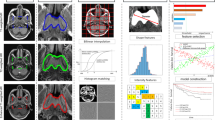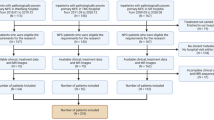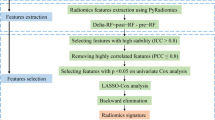Abstract
Objectives
To establish an effective dynamic nomogram combining magnetic resonance imaging (MRI) findings of primary tumor and regional lymph nodes with tumor stage for the pretreatment prediction of induction chemotherapy (IC) response in locoregionally advanced nasopharyngeal carcinoma (LANPC).
Methods
A total of 498 LANPC patients (372 in the training and 126 in the validation cohort) with MRI information were enrolled. All patients were classified as “favorable responders” and “unfavorable responders” according to tumor response to IC. A nomogram for IC response was built based on the results of the logistic regression model. Also, the Cox regression analysis was used to identify the independent prognostic factors of disease-free survival (DFS).
Results
After two cycles of IC, 340 patients were classified as “favorable responders” and 158 patients as “unfavorable responders.” Calibration curves revealed satisfactory agreement between the predicted and the observed probabilities. The nomogram achieved an AUC of 0.855 (95% CI, 0.781–0.930) for predicting IC response, which outperformed TNM staging (AUC, 0.661; 95% CI 0.565–0.758) and the MRI feature-based model alone (AUC, 0.744; 95% CI 0.650–0.839) in the validation cohort. The nomogram was used to categorize patients into high- and low-response groups. An online dynamic model was built (https://nomogram-for-icresponse-prediction.shinyapps.io/DynNomapp/) to facilitate the application of the nomogram. In the Cox multivariate analysis, clinical stage, tumor necrosis, EBV DNA levels, and cervical lymph node numbers were independently associated with DFS.
Conclusions
The comprehensive nomogram incorporating MRI features and tumor stage could assist physicians in predicting IC response and formulating personalized treatment strategies for LANPC patients.
Key Points
• The nomogram can predict IC response in endemic LANPC.
• The nomogram combining tumor stage with MRI-based tumor features showed very good predictive performance.
• The nomogram was transformed into a web-based dynamic model to optimize clinical application.




Similar content being viewed by others
Abbreviations
- AJCC:
-
American Joint Committee on Cancer
- AUC:
-
An area under the receiver operating characteristic curve
- CCRT:
-
Concurrent chemoradiation
- C-index:
-
Harrell’s concordance index
- CLN:
-
Cervical lymph node
- CR:
-
Complete response
- DCA:
-
Decision curve analysis
- DFS:
-
Disease-free survival
- DMFS:
-
Distant metastasis-free survival
- ENE:
-
Extranodal extension
- IC:
-
Induction chemotherapy
- IMRT:
-
Intensity-modulated radiation therapy
- LANPC:
-
Locoregionally advanced nasopharyngeal carcinoma
- LN:
-
Lymph node
- LRRFS:
-
Locoregional recurrence-free survival
- MRI:
-
Magnetic resonance imaging
- OS:
-
Overall survival
- PD:
-
Progressive disease
- PR:
-
Partial response
- RLN:
-
Retropharyngeal lymph node
- SD:
-
Stable disease
References
Chen YP, Chan ATC, Le QT, Blanchard P, Sun Y, Ma J (2019) Nasopharyngeal carcinoma. Lancet 394:64–80
Chen L, Mao YP, Xie FY et al (2012) The seventh edition of the UICC/AJCC staging system for nasopharyngeal carcinoma is prognostically useful for patients treated with intensity-modulated radiotherapy from an endemic area in China. Radiother Oncol 104:331–337
Al-Sarraf M, LeBlanc M, Giri PG et al (1998) Chemoradiotherapy versus radiotherapy in patients with advanced nasopharyngeal cancer: phase III randomized Intergroup study 0099. J Clin Oncol 16:1310–1317
Wee CW, Keam B, Heo DS, Sung MW, Won TB, Wu HG (2015) Locoregionally advanced nasopharyngeal carcinoma treated with intensity-modulated radiotherapy plus concurrent weekly cisplatin with or without neoadjuvant chemotherapy. Radiat Oncol J 33:98–108
Zhao LN, Zhou B, Shi M et al (2012) Clinical outcome for nasopharyngeal carcinoma with predominantly WHO II histology treated with intensity-modulated radiation therapy in non-endemic region of China. Oral Oncol 48:864–869
Mao YP, Tang LL, Chen L et al (2016) Prognostic factors and failure patterns in non-metastatic nasopharyngeal carcinoma after intensity-modulated radiotherapy. Chin J Cancer 35:103
Frikha M, Auperin A, Tao Y et al (2018) A randomized trial of induction docetaxel-cisplatin-5FU followed by concomitant cisplatin-RT versus concomitant cisplatin-RT in nasopharyngeal carcinoma (GORTEC 2006-02). Ann Oncol 29:731–736
Sun Y, Li WF, Chen NY et al (2016) Induction chemotherapy plus concurrent chemoradiotherapy versus concurrent chemoradiotherapy alone in locoregionally advanced nasopharyngeal carcinoma: a phase 3, multicentre, randomised controlled trial. Lancet Oncol 17:1509–1520
Zhang Y, Chen L, Hu GQ et al (2019) Gemcitabine and cisplatin induction chemotherapy in nasopharyngeal carcinoma. N Engl J Med 381:1124–1135
Chen YP, Ismaila N, Chua MLK et al (2021) Chemotherapy in combination with radiotherapy for definitive-intent treatment of stage II-IVA nasopharyngeal carcinoma: CSCO and ASCO guideline. J Clin Oncol 39:840–859
Pfister DG, Spencer S, Adelstein D et al (2020) Head and neck cancers, version 2.2020, NCCN clinical practice guidelines in oncology. J Natl Compr Cancer Netw 18:873–898
Luo WJ, Zou WQ, Liang SB et al (2021) Combining tumor response and personalized risk assessment: potential for adaptation of concurrent chemotherapy in locoregionally advanced nasopharyngeal carcinoma in the intensity-modulated radiotherapy era. Radiother Oncol 155:56–64
Xu Y, Wu Z, Ye W et al (2021) Prognostic value of serum uric acid and tumor response to induction chemotherapy in locally advanced nasopharyngeal carcinoma. BMC Cancer 21:519
Yao J, Wang Y, Lin Y et al (2021) The role of pretreatment (18)F-FDG PET/CT for early prediction of neoadjuvant chemotherapy response in patients with locoregionally advanced nasopharyngeal carcinoma. Drug Des Devel Ther 15:4157–4166
Zhang GY, Wang YJ, Liu JP et al (2015) Pretreatment diffusion-weighted MRI can predict the response to neoadjuvant chemotherapy in patients with nasopharyngeal carcinoma. Biomed Res Int 2015:307943
Zhao DW, Fan WJ, Meng LL et al (2021) Comparison of the pre-treatment functional MRI metrics’ efficacy in predicting locoregionally advanced nasopharyngeal carcinoma response to induction chemotherapy. Cancer Imaging 21:59
Yang Y, Wang M, Qiu K, Wang Y, Ma X (2022) Computed tomography-based deep-learning prediction of induction chemotherapy treatment response in locally advanced nasopharyngeal carcinoma. Strahlenther Onkol 198:183–193
Zhang L, Ye Z, Ruan L, Jiang M (2020) Pretreatment MRI-derived radiomics may evaluate the response of different induction chemotherapy regimens in locally advanced nasopharyngeal carcinoma. Acad Radiol 27:1655–1664
Zhao L, Gong J, Xi Y et al (2020) MRI-based radiomics nomogram may predict the response to induction chemotherapy and survival in locally advanced nasopharyngeal carcinoma. Eur Radiol 30:537–546
Ai QY, King AD, Poon DMC et al (2019) Extranodal extension is a criterion for poor outcome in patients with metastatic nodes from cancer of the nasopharynx. Oral Oncol 88:124–130
Liu Y, Chen S, Dong A et al (2020) Nodal grouping in nasopharyngeal carcinoma: prognostic significance, N classification, and a marker for the identification of candidates for induction chemotherapy. Eur Radiol 30:2115–2124
Ma H, Liang S, Cui C et al (2020) Prognostic significance of quantitative metastatic lymph node burden on magnetic resonance imaging in nasopharyngeal carcinoma: a retrospective study of 1224 patients from two centers. Radiother Oncol 151:40–46
Wan Y, Tian L, Zhang G et al (2019) The value of detailed MR imaging report of primary tumor and lymph nodes on prognostic nomograms for nasopharyngeal carcinoma after intensity-modulated radiotherapy. Radiother Oncol 131:35–44
Segara D, Krop IE, Garber JE et al (2007) Does MRI predict pathologic tumor response in women with breast cancer undergoing preoperative chemotherapy? J Surg Oncol 96:474–480
Wang X, Hu C, Ying H et al (2015) Patterns of lymph node metastasis from nasopharyngeal carcinoma based on the 2013 updated consensus guidelines for neck node levels. Radiother Oncol 115:41–45
Chong VF, Fan YF, Khoo JB (1996) MRI features of cervical nodal necrosis in metastatic disease. Clin Radiol 51:103–109
King AD, Tse GM, Ahuja AT et al (2004) Necrosis in metastatic neck nodes: diagnostic accuracy of CT, MR imaging, and US. Radiology 230:720–726
King AD, Tse GM, Yuen EH et al (2004) Comparison of CT and MR imaging for the detection of extranodal neoplastic spread in metastatic neck nodes. Eur J Radiol 52:264–270
van den Brekel MW, Stel HV, Castelijns JA et al (1990) Cervical lymph node metastasis: assessment of radiologic criteria. Radiology 177:379–384
Eisenhauer EA, Therasse P, Bogaerts J et al (2009) New response evaluation criteria in solid tumours: revised RECIST guideline (version 1.1). Eur J Cancer 45:228–247
Jiang YT, Chen KH, Yang J et al (2021) Establishment of a prognostic nomogram for patients with locoregionally advanced nasopharyngeal carcinoma incorporating TNM stage, post-induction chemotherapy tumor volume and Epstein-Barr virus DNA load. Front Oncol 11:683475
Jiang YT, Chen KH, Liang ZG et al (2022) A nomogram based on tumor response to induction chemotherapy may predict survival in locoregionally advanced nasopharyngeal carcinoma. Head Neck. https://doi.org/10.1002/hed.27020
Liu LT, Tang LQ, Chen QY et al (2015) The prognostic value of plasma Epstein-Barr viral DNA and tumor response to neoadjuvant chemotherapy in advanced-stage nasopharyngeal carcinoma. Int J Radiat Oncol Biol Phys 93:862–869
Peng H, Chen L, Zhang Y et al (2016) The tumour response to induction chemotherapy has prognostic value for long-term survival outcomes after intensity-modulated radiation therapy in nasopharyngeal carcinoma. Sci Rep 6:24835
Spring LM, Fell G, Arfe A et al (2020) Pathologic complete response after neoadjuvant chemotherapy and impact on breast cancer recurrence and survival: a comprehensive meta-analysis. Clin Cancer Res 26:2838–2848
Jiang YT, Chen KH, Yang J et al (2022) Prognostic significance of wait time for radical radiotherapy in locoregionally advanced nasopharyngeal carcinoma. Head Neck. https://doi.org/10.1002/hed.27011
Liang H, Xiang YQ, Lv X et al (2017) Survival impact of waiting time for radical radiotherapy in nasopharyngeal carcinoma: a large institution-based cohort study from an endemic area. Eur J Cancer 73:48–60
Wang XS, Zhang YJ, Liu XL, Zhou ZR, Hu CS, Eisbruch A (2011) The role of technetium-99m methoxyisobutyl isonitrile scintigraphy in predicting the therapeutic effect of chemotherapy against nasopharyngeal carcinoma. Cancer 117:2435–2441
Zhao B, Tan Y, Tsai WY et al (2016) Reproducibility of radiomics for deciphering tumor phenotype with imaging. Sci Rep 6:23428
Huang L, Zhang Y, Liu Y et al (2019) Prognostic value of retropharyngeal lymph node metastasis laterality in nasopharyngeal carcinoma and a proposed modification to the UICC/AJCC N staging system. Radiother Oncol 140:90–97
Liang SB, Chen LS, Yang XL et al (2021) Influence of tumor necrosis on treatment sensitivity and long-term survival in nasopharyngeal carcinoma. Radiother Oncol 155:219–225
Manoochehri Khoshinani H, Afshar S, Najafi R (2016) Hypoxia: a double-edged sword in cancer therapy. Cancer Investig 34:536–545
Wang M, Li X, Qu Y, Xu O, Sun Q (2013) Hypoxia promotes radioresistance of CD133-positive Hep-2 human laryngeal squamous carcinoma cells in vitro. Int J Oncol 43:131–140
Cimmino F, Avitabile M, Lasorsa VA et al (2019) HIF-1 transcription activity: HIF1A driven response in normoxia and in hypoxia. BMC Med Genet 20:37
He M, Wu H, Jiang Q et al (2019) Hypoxia-inducible factor-2alpha directly promotes BCRP expression and mediates the resistance of ovarian cancer stem cells to adriamycin. Mol Oncol 13:403–421
Dong L, You S, Zhang Q et al (2019) Arylsulfonamide 64B inhibits hypoxia/HIF-induced expression of c-Met and CXCR4 and reduces primary tumor growth and metastasis of uveal melanoma. Clin Cancer Res 25:2206–2218
Huang J, Gao L, Li B et al (2019) Knockdown of hypoxia-inducible factor 1alpha (HIF-1alpha) promotes autophagy and inhibits phosphatidylinositol 3-kinase (PI3K)/AKT/mammalian target of rapamycin (mTOR) signaling pathway in ovarian cancer cells. Med Sci Monit 25:4250–4263
Mermod M, Tolstonog G, Simon C, Monnier Y (2016) Extracapsular spread in head and neck squamous cell carcinoma: a systematic review and meta-analysis. Oral Oncol 62:60–71
Du XJ, Tang LL, Chen L et al (2015) Neoadjuvant chemotherapy in locally advanced nasopharyngeal carcinoma: defining high-risk patients who may benefit before concurrent chemotherapy combined with intensity-modulated radiotherapy. Sci Rep 5:16664
Xu C, Sun R, Tang LL et al (2018) Role of sequential chemoradiotherapy in stage II and low-risk stage III-IV nasopharyngeal carcinoma in the era of intensity-modulated radiotherapy: a propensity score-matched analysis. Oral Oncol 78:37–45
Yao JJ, Jin YN, Liu ZG et al (2019) Do all patients with advanced N-stage nasopharyngeal carcinoma benefit from the addition of induction chemotherapy to concurrent chemoradiotherapy? Ther Adv Med Oncol 11:1758835919833863
Lee AW, Lin JC, Ng WT (2012) Current management of nasopharyngeal cancer. Semin Radiat Oncol 22:233–244
Yeo ELL, Li YQ, Soo KC, Wee JTS, Chua MLK (2018) Combinatorial strategies of radiotherapy and immunotherapy in nasopharyngeal carcinoma. Chin Clin Oncol 7:15
Lee NY, Zhang Q, Pfister DG et al (2012) Addition of bevacizumab to standard chemoradiation for locoregionally advanced nasopharyngeal carcinoma (RTOG 0615): a phase 2 multi-institutional trial. Lancet Oncol 13:172–180
Funding
This study has received funding by the Key Research and Development Program Project of Guangxi Zhuang Autonomous Region (Grant No. GuikeAB18221007), Youth Science Foundation Project of Guangxi Medical University (Grant No. GXMUYSF202122), the Independent Project of Key Laboratory of Early Prevention & Treatment for Regional High-Incidence-Tumor (Grant No. GKE-ZZ202014), the Self funded research project of Health Commission of Guangxi Zhuang Autonomous Region (Z20210913), and the Guangxi University Young and middle-aged Teachers (scientific research) basic ability Improvement project (Grant No. 2020KY03038).
Author information
Authors and Affiliations
Corresponding author
Ethics declarations
Guarantor
The scientific guarantor of this publication is Xiaodong Zhu.
Conflict of interest
The authors declare that they have conflict of interest.
Statistics and biometry
No complex statistical methods were necessary for this paper.
Informed consent
Written informed consent was not required for this study because the retrospective nature of the study.
Ethical approval
Institutional Review Board approval was obtained.
Methodology
• retrospective
• diagnostic or prognostic study
• performed at one institution
Additional information
Publisher’s note
Springer Nature remains neutral with regard to jurisdictional claims in published maps and institutional affiliations.
Supplementary information
ESM 1
(DOCX 59 kb)
Rights and permissions
Springer Nature or its licensor (e.g. a society or other partner) holds exclusive rights to this article under a publishing agreement with the author(s) or other rightsholder(s); author self-archiving of the accepted manuscript version of this article is solely governed by the terms of such publishing agreement and applicable law.
About this article
Cite this article
Jiang, Y., Liang, Z., Chen, K. et al. A dynamic nomogram combining tumor stage and magnetic resonance imaging features to predict the response to induction chemotherapy in locally advanced nasopharyngeal carcinoma. Eur Radiol 33, 2171–2184 (2023). https://doi.org/10.1007/s00330-022-09201-8
Received:
Revised:
Accepted:
Published:
Issue Date:
DOI: https://doi.org/10.1007/s00330-022-09201-8




